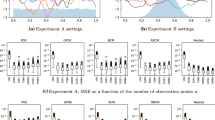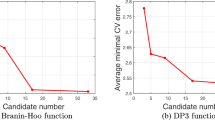Abstract
Under usual estimation practice with local search windows for data and for interpolation situations, universal kriging and ordinary kriging yield the same estimates, using a data set with apparent trend, for both the unknown attribute and its trend component. Modeling the trend matters only in extrapolation situations. Because conditions of the case study presented arise most frequently in practice, the simpler ordinary kriging is the preferred option.
Similar content being viewed by others
References
Aboufirassi, M., and Mariño, M., 1983, Kriging of Water Levels in the Souss Aquifer, Morocco: Math. Geol., v. 15, p. 537–551.
Anderson, T. W., 1971, The Statistical Analysis of Time Series: John Wiley & Sons, New York, 704 p.
Armstrong, M, 1984, Problems with Universal Kriging: Math. Geol., v. 16, p. 101–108.
Berryhill, H. L., and Swanson, U. E., 1962, Revised Stratigraphic Nomenclature from Upper Pennsylvania and Lower Permian Rocks, Washington County, PA: U.S. Geol. Survey Prof. Paper 450-C, p. C43–46.
Buxton, B. E., 1982, Coal Reserve Assessment: A Geostatistical Case-Study: unpub. MSc. thesis, Stanford University, 84 p.
David, M., 1975, The Practice of Kriging:in Guarascioet al. (Eds.), Advanced Geostatistics in the Mining Industry: Reidel, Dordrecht, The Netherlands, p. 31–48.
Delfiner, P., 1975, Linear Estimation of Nonstationary Spatial Phenomena:in Guarascioet al. (Eds.), Advanced Geostatistics in the Mining Industry, Reidel, Dordrecht, The Netherlands, p. 49–68.
Goldberger, A., 1962, Best Linear Unbiased Prediction in the Generalized Linear Regression Model: JASA, v. 57, p. 369–375.
Gómez, M., and Hazen, K., 1970, Evaluation of Sulfur and Ash Distribution in Coal Seams by Statistical Response Surface Regression Analysis: U.S. Bureau of Mines, Report 7377, 120 p.
Isaaks, E., and Srivastava, R. M., 1988, Spatial Continuity Measures for Probabilistic and Deterministic Geostatistics: Math. Geol., v. 20, p. 313–341.
Journel, A. G., and Huijbregts, Ch., 1978, Mining Geostatistics: Academic Press, New York, 600 p.
Journel, A. G., 1986, Geostatistics: Models and Tools for the Earth Sciences: Math. Geol., v. 18, p. 119–140.
Luenberger, D., 1969, Optimization by Vector Space Methods: John Wiley & Sons, 326 p.
Matheron, G., 1971, The Theory of Regionalized Variables and Its Applications: Fasc. 5, Paris School of Mines, 212 p.
Myers, D. E., 1988, Interpolation with Positive Definite Functions:in Sciences de la Terre, Ecole de Geologie, Nancy, v. 28, p. 251–265.
Olea, R. A., 1975, Optimum Mapping Techniques Using Regionalized Variables Theory:in Series on Spatial Analysis, v. 2, Kansas Geol. Survey, Lawrence.
Author information
Authors and Affiliations
Rights and permissions
About this article
Cite this article
Journel, A.G., Rossi, M.E. When do we need a trend model in kriging?. Math Geol 21, 715–739 (1989). https://doi.org/10.1007/BF00893318
Received:
Accepted:
Issue Date:
DOI: https://doi.org/10.1007/BF00893318




